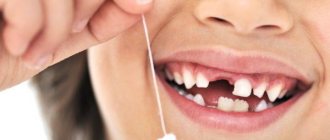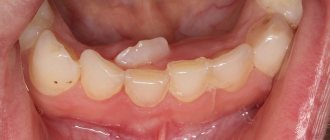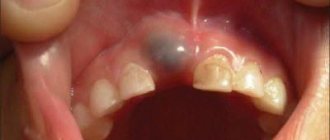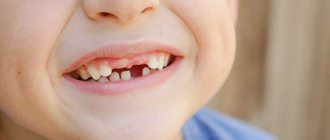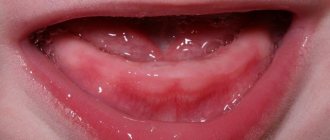The formation of teeth is a complex step-by-step process that begins in the first weeks of intrauterine life. Thus, by the time of birth, the baby has the rudiments of 20 primary and 16 permanent teeth inside each jaw. But, like all stages of development, teething in children under one year and older occurs differently. Some endure this period relatively calmly, others are capricious and sleep poorly. Why this happens and how to understand that the baby is cutting teeth, we will tell you further.
Timing of teething in children
On average, the first teeth in healthy children appear at 5–6 months. But sometimes it happens that someone has a white bump visible at 4 months, and someone smiles with a toothless mouth even at 8-12 months. And this is not a deviation from the norm. According to studies by a number of authors, the timing differs depending on the region of residence, race, and gender of the child. For example, children in the southern regions develop teeth a little earlier than those in the north. The formation of temporary teeth is also influenced by the following factors:
- heredity;
- maternal toxicosis in the second and third trimester of pregnancy;
- prematurity;
- artificial feeding;
- quality of drinking water;
- hypothyroidism and other endocrine pathologies;
- infectious diseases;
- weakened immunity;
- rickets.
It is impossible to speed up the timing and influence the sequence of teething in children. The only thing parents can do at this time is to alleviate the baby’s condition if he is restless and in pain (more on this below).
Reasons for violation
The lower and upper teeth are formed in children at different times. The main factor that influences this is heredity, that is, the predisposition is laid down in genes, as is the quality of dentin, as well as the enamel layer. If mom or dad, grandfather or grandmother, or other relatives had cases of deviation from the order of appearance of chewing organs, this can be inherited by the toddler. Therefore, the child’s teeth grow out of order.
Of course, relatives are always worried when the growth process is delayed and goes astray from the generally accepted schedule. But dentists say that non-standard situations are also normal:
- When the appearance of units occurs several months earlier or later;
- If the order of appearance of the masticatory organs is disrupted;
- When the rate of growth of units does not coincide with the announced scheme;
Since the process of growth of incisors, canines, and molars begins at 12 weeks of pregnancy, it is influenced by the health of the mother. Influenza, bad habits of the mother in labor, and infectious diseases have a negative impact. Artificial feeding has a bad effect on the newborn's body. After all, sucking the mother's breast actively develops the facial muscles, and the correct development of the lower jaw occurs. Sucking from bottles occurs only with the help of the lips. As a result, the first tooth may appear in the top row. In this case, therapy is not needed. It is important that all 20 time units appear.
Remember! Medicine does not know of cases where children were left without chewing organs due to their untimely appearance. The units will appear, you just need to wait.
It wouldn't hurt to go to the dentist. If necessary, bite correction in children is carried out. In addition, a non-standard order can be observed in babies if their parents are of different nationalities, or if the climate is not suitable for the newborn. Many parents see disordered teething as a sign of rickets. Doctors explain that with rickets, babies have a large head, protruding ribs, and excessive sweating. If the pediatrician does not find these signs, then there is no reason to worry. But sometimes the absence of the first units up to a year indicates:
- Vitamin D deficiency in the body;
- Violation of metabolic processes;
- Gastrointestinal problems;
- Chronic diseases;
- Infectious diseases such as measles, scarlet fever;
- Lack of rudiments of future chewing organs;
- Horizontal position of the unit in the gum;
- Bite abnormalities;
- Dysfunction of the endocrine gland system;
- Slow development of the body;
Diagnosis and consultation with a pediatrician or pediatric dentist will clarify the situation and eliminate the problem.
Subsequence
The order in which teeth appear may vary, which is rare and is not considered pathological. For some boys and girls, the upper incisors appear first, rather than the lower incisors as usual. But basically the sequence of teething in children is as follows (teeth appear in pairs):
- lower central incisors;
- upper central incisors;
- upper lateral incisors;
- lower lateral incisors;
- first upper molars (molars);
- first lower molars;
- upper canines;
- lower canines;
- second lower molars;
- second upper molars.
By the age of 2.5–3 years, the child has a full set of baby teeth: 10 on each jaw. After about 4–6 years, the roots begin to dissolve, the teeth lose support and fall out in the same order in which they erupted.
As the jaw and facial bones grow, spaces form between the primary teeth. This provides space for permanent, larger teeth to emerge, which erupt from 5 to 15 years of age.
When does a baby's first teeth erupt?
All babies cut their teeth according to their own individual program: for some this process begins earlier, for others later. As practice shows, most children have their first tooth between the ages of 6 and 8.5 months, and by the age of one year, every healthy child has at least one baby tooth in their mouth.
At the age of three to four months, the teeth that are preparing to erupt begin to make themselves known quite actively: the baby becomes capricious, cries, and tries to bite everything that falls into his hands.
The very first to appear are usually the two lower ones, located in the center of the tooth (lower central incisors or “ones”). Then - the central upper incisors, followed by approximately ten months of age, the upper “twos”, or lateral upper incisors, erupt. By eleven to twelve months, the lateral incisors can be seen on the lower jaw. Thus, ideally, a one-year-old child is the happy owner of eight baby teeth.
By about sixteen months, many babies already have their first molars at the bottom and top. Fangs (“threes”) appear above and below later, in the eighteenth to twenty-second months of a child’s life. The upper and lower second molars erupt between 24 and 33 months of age. But again, it should be remembered that this process is individual and the order of teething may also be different.
Often teeth grow in pairs: two, and sometimes four at a time. Girls generally erupt teeth earlier than boys. By the age of 2.5-3 years, a child can find a full set of twenty fully erupted teeth.
Caution must be exercised if a child who is almost one year old does not have a single tooth. In principle, some children may have a congenital feature in the form of late teething, but you should not draw any conclusions on your own; you should definitely consult with a qualified specialist who, if necessary, will prescribe additional examinations.
Causes of late teething in children:
- hereditary predisposition, which is a variant of the norm and can be traced in other blood relatives;
- decreased thyroid function;
- rickets;
- diseases of the digestive system;
- disorders of enzymatic (fermentation) metabolism;
- pituitary insufficiency;
- lack of calcium in the child’s body;
- genetically determined diseases.
For the baby himself, the process of teething can proceed in different ways. Some children experience virtually no discomfort, others suffer from pain, their sleep is disturbed, their appetite worsens, their temperature rises (up to 38-39̊C), salivation increases, they may experience nasal congestion, a wet cough (due to excessive salivation), constipation, or, conversely, , increased bowel movements.
Experts recommend starting to care for your child’s oral cavity even before the first teeth erupt: in the morning and evening, before going to bed at night, the child’s gums should be carefully wiped with a swab previously moistened with warm water. After the first teeth appear, you need to clean them with a special finger brush, which can also be used to massage the gum tissue. The front teeth should be brushed with vertical movements, the side teeth should be brushed in a circular motion.
The Healthy Smile network of dental clinics employs experienced pediatric dentists, with whom you can schedule your child for a free consultation.
The Healthy Smile clinics provide discounts for regular customers, family discounts, various payment methods are possible, and the list of promotional offers to reduce the cost of certain types of services, including for children, is regularly updated.
Symptoms
Usually, no serious problems arise during teething, but local (in rare cases systemic) disturbances are present. These include:
- swelling and soreness of the gums;
- profuse drooling;
- irritability;
- restless sleep;
- lethargy;
- the baby's need for biting and chewing;
- poor appetite.
Loose stools, low-grade fever and runny nose are less common than the above symptoms.
Important! If the body temperature rises above 38 degrees, convulsions, difficulty breathing, you need to show the baby to a doctor and call an ambulance. This may indicate a viral infectious disease and is not a sign of teething.
Some parents wonder why this process occurs differently in babies. For example, in some teething occurs with fever, in others it does not. It is noted that, among other factors, this is also influenced by the child’s constitutional type. In children of the allergic type, this period may be accompanied by increased moodiness, atopic dermatitis, and ARVI is often associated. Infants with asthenic syndrome sleep poorly, refuse to eat, and cry for a long time due to severe pain.
How to help your baby teething
To eliminate unpleasant symptoms and make the child feel better, parents are advised to:
- Buy teethers made of silicone or special soft plastic filled with water. These devices are cooled to a comfortable temperature (not frozen) and given to the baby. Cold reduces pain in the gums and relieves swelling.
- Massage your gums. To do this, an adult needs to wrap his finger in a clean gauze swab, moisten it in cool boiled water and lightly massage the inflamed area.
- Give ibuprofen or paracetamol if the child is very restless or has a high fever. The dosage is prescribed by the doctor.
Important! During teething, babies put everything in their mouth, which can cause a secondary infection. Therefore, parents need to carefully monitor oral hygiene, regularly wipe their face with a clean towel, and gently blot saliva.
As for special gels for gums, you need to be careful and not use them too often, as some components can cause an allergic reaction.
Caring for baby teeth
You need to take care of your teeth immediately after teething. Moms do it first. For adults, special finger brushes have been created that are convenient for cleaning teeth from plaque, but so far without toothpaste. When the baby learns to rinse his mouth and spit, they move on to brushing with children's toothpaste without fluoride (this can be done earlier if the tube indicates that the toothpaste is from 0 years). So, gradually, the child will form a useful habit of caring for the oral cavity.
Another important reason for caring for teeth from infancy is that it affects the formation of permanent teeth and bite. For example, caries of a temporary tooth can transfer to the germ of a permanent one. And early loss (before 5 years) of a baby tooth will lead to uneven dentition in the future. If the molar does not begin to grow in time, the adjacent baby teeth will move and fill the resulting space.
Replacing baby teeth with permanent teeth
Eruption of molars begins at the age of 6-7 years. First, the large molars are shown (usually on the lower jaw). Then the pattern of baby teeth eruption is repeated. The incisors on the lower jaw are the first to change, and at the age of 7-8 years, the incisors on the upper jaw are also replaced. At the same time, the lower lateral incisors can also change.
At 8-9 years old, the upper incisors will change. It's the fangs' turn. At the same time (9-10 years), teeth that were not in the primary occlusion - premolars - begin to grow. There are four premolars on each jaw - two on the left and two on the right. At the age of 12, the fangs on the upper jaw will change. At this stage, the formation of the height of the bite begins, which has both aesthetic and functional significance.
The last teeth (wisdom teeth or third molars) appear between the ages of 17 and 25. Only after this can we say that the formation of the dental arches is completely completed.
When replacing baby teeth with permanent molars, it is important to pay attention to the bite. It is easy to correct at a young age, while adults will have to correct it throughout their lives. By regularly visiting a pediatric dentist, you can intervene in the process of bite formation in a timely manner. In addition, a specialist can monitor the eruption of baby and molar teeth (so that it is not too early or late), give recommendations to alleviate the child’s condition, and recommend special baby suppositories or gels for teething.

